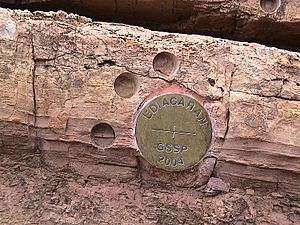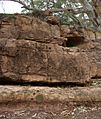Ediacaran facts for kids
The Ediacaran period was a time in Earth's history, lasting from about 635 to 541 million years ago. It's named after the Ediacara Hills in South Australia. This period was the very last part of the Proterozoic eon, which is a huge chunk of Earth's early history. After the Ediacaran came the Cambrian period, which was the start of the Paleozoic era.
The Ediacaran period is super famous because it's when we find the first fossils of larger, more complex living things. Scientists think these might be the very first animals! These fossils aren't bones or shells, but rather impressions or trace fossils left behind by soft-bodied creatures. They were first discovered in Charnwood Forest in England. For over 60 years, no one quite knew what they were until similar fossils were found in South Australia.
In 2004, a group of scientists called the International Union of Geological Sciences (IUGS) officially recognized the Ediacaran as a real geological period. This was a big deal because it was the first new geological period added in 120 years!
Contents
What Was the Vendian Period?
Before it was officially called the Ediacaran, this time was often known as the Vendian period. A Russian scientist named Boris Sokolov suggested the name "Vendian" in 1952. You might still hear people use the term Vendian today.
However, the two terms aren't exactly the same. The Vendian period was a bit longer. It included a huge ice age called the Marinoan glaciation, which was part of the "Snowball Earth" event. This means the Vendian also covered the last part of the Cryogenian period.
When Did the Ediacaran Period Start and End?
The Ediacaran period lasted for about 90 million years. It began right after the end of the Cryogenian "Snowball Earth" ice age. The start is marked by a special layer of rock called a "cap carbonate." This rock layer sits on top of old glacial deposits and shows a sudden change in climate.
The Ediacaran period ended with the first appearance of certain trace fossils, like Trichophycus pedum, all over the world. This also marked the beginning of the Cambrian period. Sadly, the end of the Ediacaran also saw a mass extinction where most of the unique Ediacaran creatures disappeared.
Scientists haven't been able to get an exact date for the start of the Ediacaran period in South Australia, where it's officially defined.
Ediacaran Life Forms
The Ediacaran period is famous for its unique life forms, known as the Ediacaran biota. These are the oldest definite multicellular organisms we know of. Their fossils are mostly impressions or traces left by soft-bodied creatures. They came in many shapes, like segments, fronds (leaf-like shapes), disks, or bags. We don't find any skeletons or shells from this time.
| Precambrian (4.567 gya – 541 mya) | |
|---|---|
| In the left column are Eons, bold are Eras, not bold are Periods. gya = billion years ago, mya = million years ago | |
| Hadean (4.567 gya – 4 gya) | Chaotian Zirconian |
| Archaean (4 gya – 2.5 gya) | Eoarchaean (4 gya – 3.6 gya)
Palaeoarchaean (3.6 gya – 3.2 gya) |
| Proterozoic (2.5 gya – 541 mya) | Palaeoproterozoic (2.5 gya – 1.6 gya) Siderian (2.5 gya – 2.3 gya) Rhyacian (2.3 gya – 2.05 gya) Orosirian (2.05 gya – 1.8 gya) Statherian (1.8 gya – 1.6 gya)
Mesoproterozoic (1.6 gya – 1 gya) Calymmian (1.6 gya – 1.4 gya) Ectasian (1.4 gya – 1.2 gya) Stenian (1.2 gya – 1 gya) Neoproterozoic (1 gya - 541 mya) Tonian (1 gya – 720 mya) Cryogenian (720 mya – 635 mya) Ediacaran (635 mya – 541 mya) |
Images for kids
-
Archaeaspinus, one of the interesting creatures from the Ediacaran biota. It belongs to a group called Proarticulata, which also includes Dickinsonia and other early organisms.
See also
 In Spanish: Período Ediacárico para niños
In Spanish: Período Ediacárico para niños




